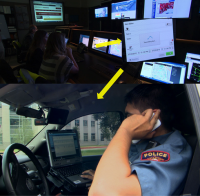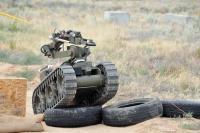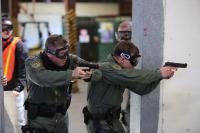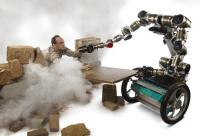-
Integrating military, civilian trauma care systems could prevent up to 20% of U.S. trauma deaths
The leading cause of death for Americans under the age of 46 is trauma — a disabling or life-threatening physical injury that results from an event such as a motor vehicle crash, gun violence, or fall. In 2013, trauma cost approximately $670 billion in medical care expenses and lost productivity. Of the 147,790 U.S. trauma deaths in 2014, as many as 20 percent — or about 30,000 — may have been preventable after injury with optimal trauma care. Mass casualty incidents and increasing foreign and domestic threats to homeland security lend urgency to the translation of wartime lessons to civilian trauma systems, says a new report.
-
-
Datacasting helps first responders with live video streaming via smartphone

When torrential storms caused widespread flooding in Houston, Texas, in mid-April, first responders needed a way securely to share information amongst their many organizations. Luckily the DHS S&T First Responders Group’s (FRG) datacasting system was available. Datacasting provides public safety users with the capability to transmit secure video and data over existing broadcast television signals to a targeted audience. Even in an emergency situation, where other wireless services often fail due to network congestion, datacasting still provides a reliable platform to quickly send large files.
-
-
Hazardous-devices teams compete at the Robot Rodeo, 14-17 June

Hazardous-devices teams from around the Southwest will wrangle their bomb-squad robots at the tenth annual Robot Rodeo beginning Tuesday, 14 June, at Los Alamos National Laboratory. “The Robot Rodeo gives bomb-squad teams the opportunity to practice and hone their skills in a lively but low-risk setting,” said a member of the Laboratory’s hazardous-devices team.
-
-
Last surviving 9/11 search-and-rescue dog dies, receives hero's send-off
The last surviving search and rescue dog who worked at Ground Zero following the 9/11 terrorist attacks died on Monday. Bretagne, a 16-year-old golden retriever, was put down at Fairfield Animal Hospital in Cypress, Texas. As Bretagne slowly walked into the hospital, she was saluted by representatives of state agencies who came to pay their respects.
-
-
Seismic networks can serve as the backbone for 21st century firefighting
The same twenty-first century communications network used for real-time seismic monitoring in Nevada and parts of California can provide high-quality images to help first responders catch fires before they grow costly and dangerous. Experts say that seismic networks in place to provide earthquake early warning, if designed to sustain multi-hazard monitoring, can provide a robust data backbone for fire cameras that pan, tilt and zoom as they monitor wildfires and other extreme weather events like remote floods.
-
-
Active shooter exercise evaluates tactics, technologies

The New York Police Department (NYPD), the Fire Department of New York (FDNY), and the Department of Homeland Security (DHS) Science and Technology Directorate (S&T) took part in an active shooter exercise early Sunday at a Brooklyn high school to evaluate tactics and technologies for responding to and containing rapidly escalating shooting incidents.
-
-
Israel EMS team trains Panamanian medics for terror attack
United Hatzalah, the national volunteer EMS service in Israel, sent a delegation of EMTs, paramedics, doctors, and logistics personnel to Panama to train their counterparts in providing the proper response for a Mass Casualty Incident (MCI).
-
-
Historic preservation often neglected in disaster plans
Many communities fail to take historic preservation into account when planning for natural disasters, risking a loss of heritage and critical engines of the local economy in the event of catastrophe. Thousands of historic sites are left exposed to risk from floods and storms. “A lot of cultural and historic resources worldwide are at risk when natural hazards strike,” said the author of a recent study. “And even though we know this, very few resources are dedicated to protecting them.”
-
-
Sandia to help California in emergency response planning, training
Sandia National Laboratories and the California Fire and Rescue Training Authority (CFRTA) this month signed a memorandum of agreement to develop new concepts and capabilities for emergency planning, exercise and response. The agreement provides a framework of cooperation in a variety of vital areas of emergency response planning and training at the California Exercise Simulation Center (CESC) in Mather. The CESC is an exercise and research facility operated by the CFRTA that helps prepare first responders and incident commanders by simulating catastrophic and complex emergency scenarios at low cost.
-
-
Protecting firefighters from harm
If there is anything common among the 1.1 million firefighters — both career and volunteer — serving in the United States, it is that at any moment, they may be required to put their lives on the line to protect people and property from disaster. But who helps protect these dedicated public servants from the on-the-job dangers they face?
-
-
Modern buildings have an alarming flaw when people need to escape quickly
The landscapes in which many of us live would have been unimaginable to previous generations. We now have skyscrapers so striking and tall they would make Icarus turn pale. Yet in emergency situations, our seemingly brilliant designs sometimes turn against us – and become death traps when disaster strikes. There is a major problem with the way we evaluate the safety of the structures in which we live and work. Until we address it, our chances of survival are a little like those of the characters from Greek legend – in the lap of the gods.
-
-
New laser-based aircraft tracking system to aid in disaster relief efforts
A ground-breaking tracking system called HYPERION, based on eye-safe lasers, could enable aircraft, unmanned aerial vehicles (UAVs), and even orbiting satellites to transmit vital data to ground stations more securely, quickly and efficiently. HYPERION, offering major benefits compared with the traditional radio frequency (RF) data transmission systems currently relied on in the UAV sector, could allow UAVs engaged in disaster monitoring, surveying, search and rescue, and other humanitarian missions to send detailed images more rapidly back to the ground for analysis.
-
-
Applications solicited for funding of next-gen first-response technologies
DHS Science and Technology Directorate (S&T) says that applications are now being accepted through 9 March 2016 for the NextGen First Responder Technologies solicitation, an opportunity for joint-funding by DHS S&T and their partners in the Israeli Ministry of Public Security.
-
-
DHS, DoE, U.S. Army test operational effectiveness of technology solutions
Understanding the true potential of a new technology comes with the opportunity to deploy it in a real life, urban environment scenario against adaptive adversaries. Recently, the Department of Homeland Security (DHS) Science and Technology Directorate (S&T) collaborated with the U.S. Army to assess the operational effectiveness of twenty-five technologies through practical application.
-
-
In emergencies, don’t trust a robot too much

In emergencies, people may trust robots too much for their own safety, a new study suggests. In a mock building fire, test subjects followed instructions from an “Emergency Guide Robot” even after the machine had proven itself unreliable — and after some participants were told that robot had broken down.
-
More headlines
The long view
The Surprising Reasons Floods and Other Disasters Are Deadlier at Night
It’s not just that it’s dark and people are asleep. Urban sprawl, confirmation bias, and other factors can play a role.
Why Flash Flood Warnings Will Continue to Go Unheeded
Experts say local education and community support are key to conveying risk.
